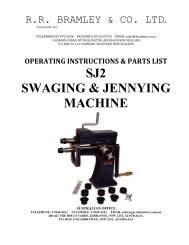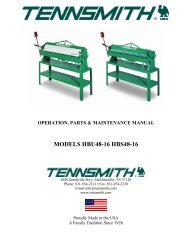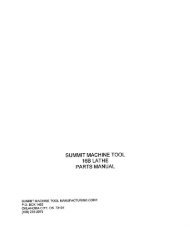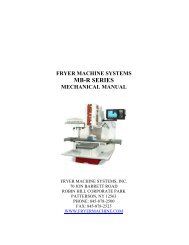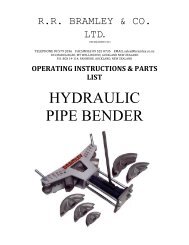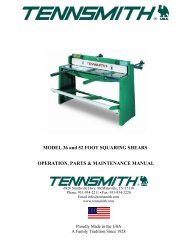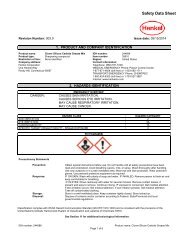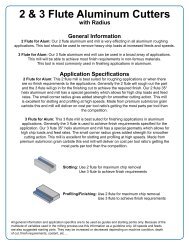Create successful ePaper yourself
Turn your PDF publications into a flip-book with our unique Google optimized e-Paper software.
lade, so the brush contacts the saw teethonly lightly to do an effective job of cleaningthe tooth gullets, without abrading saw teethor excessively wearing the brush.5. Blade tension adjustment.To tension blade to recommended tension:Set the torque wrench to 25 ft/lbs. To set thewrench, loosen the lock nut at the bottom ofthe handle and turn the knurled handle untilthe witness marks line up at 25 ft/lbs asshown in drawing 411600. Tighten lock nut.See also drawing number 446875.Insert the torque wrench into socket locatedon the inside left of the frame next to the idlewheel. Tighten the screw until the wrench"clicks". This is the proper tension for a 1¼"blade. DO NOT over torque as damage to thesaw could result.6. Sawing force check.The hydraulic sawing force systemmeasures work piece resistance to the bladewhile sawing, applying uniformly controlledforce to the blade for accurate sawing regardlessof configuration, size or type work piece.Sawing force range for this machine is 30 to120 pounds, dialed at the metering valve onthe guide arm. Too much or too little sawingforce results in uneven sawing or brokenblades.With each blade change, inspect the bladeguides for chips and sludge build up. Theyprevent blade guides and metering valvelinkage from working properly, producingother than the sawing force dialed at themetering valve.Sludge in the coolant or hydraulic fluid, a malfunctioningmetering valve or linkage from theblade to the metering valve alters the actualforce the blade applies to the work piece.Use preventive maintenance.Sawing force is adjusted by setting thelength the linkage from the metering valve tothe carbide backup slipper travels. This travelshould be between .030" - .040" as shown inenclosed drawing #446805.7. Blade guide inspection.NOTE: Consider this item and the next twoitems on linkage and metering valveinspection before making adjustments.Routinely, when changing blades, check theguide rollers and backup slipper for dirt andsludge. Also check for proper guide rollerclearance and that the rollers are freewheeling.Normally, guides require adjustment onlyafter years of wearing in.If stock or material handling equipment nearthe machine bumps the guides they willbreak or misalign and require adjustment orreplacement. Following are three preventivemaintenance checks.a. Clean, inspect and adjust the guiderollers.(1) Guides are factory set .001 widerthan the blade size..042 blade thickness requires .043 guideroller clearance.See the contents page for the blade guideprint. Guide rollers adjusted too tight or tooloose cause erratic sawing rates, inaccuratecuts and broken blades.Release blade tension and lock or tag out theelectric disconnect.(2) Remove the blade and flush out theguides.(3) Check roller clearance with feelergauges, or, assemble a new blade on themachine and tension it. Look for a tight orloose fit.Force the tensioned blade down out of theguide. It must only partly return up into theguide rollers when released.(4) Look for blade movement in thesawing area between the guides.Twist the blade back and forth between theblade wheel and guide.(5) If feeler gauges read correct, or if thetensioned blade only partly returns whenpushed down out of the rollers and there isno blade movement between the guideswhen twisted from outside the guides,problems with the sawing force check are notwith guide roller clearance.Go to item 8 on metering valve linkagecheck.(6) If step (5) failed, adjust the guiderollers.Raise the saw head. Release blade tensionand lock or tag out the electric disconnectswitch.14



